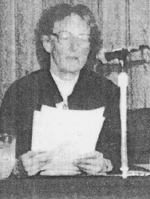|
Series:
Book Review
Author:
Dr.
Mehrborzin Soroushian
Subtopics:
General
Information:
Mazda Publishers, 1992
P.O. Box 2603,
Costa Mesa, Ca 92626
Related
Articles:
Related
Links:
Mary Boyce
|
The Author: Mary Boyce, Professor Emeritus of Iranian Studies,
now in retirement from her professional life of research and teaching at the
University of London, School of Oriental Studies is a recognized name when it
comes to Zarathushtrian Studies in recent times.
She was born in the second decade of the 20th century, and
spent part of her early life in Colonial India, where her father was stationed
as a British civil administrator for India.
Her sojourn in India and her contacts there seem to have aroused her
interest in pursuing ancient Iranian studies.
Mary Boyce received her Ph.D. in Oriental studies from Cambridge
University in 1945. A university association enabled her to research Manichaeism, an offshoot of
Zarathushtrianism.
With her appointment at the University of London School of Oriental
studies, first as a lecturer in 1947 and subsequently as a Professor in 1963,
Mary Boyce concentrated her subsequent work on the study of Zarathushtrianism
and its influence on other religions.
Establishing a network of contacts with Zartoshties in Iran,
India and elsewhere, and spending considerable time with them, Mary Boyce
adapted a unique approach to her research into Zarathushtrianism.
Rather than concentrating on the studies of the Gathas, the poetic
compositions of prophet Zarathushtra, she chose to focus on the analysis of the
rituals and the traditions of the living Zartoshties as a key to deciphering the
secret of the ancient religion. In
the course of her professional life Professor Boyce has produced an commendable
amount of literature that has helped further our understanding of the evolution
of the Zarathushtrian religion since its inception.
Although her approach to the study of the religion of Zarathushtra
emphasizing rituals rather than the philosophical dimension of the faith has
raised some eyebrows, her long life of professional dedication to the study of
the religion of Zarathushtra has been of great significance, and her painstaking
attention to uncovering the fine details of the Zarathushtrian traditions over
the ages has done much to produce a
comprehensive picture of the world’s longest surviving religion.
The Book: Dr. Ehsan Yarshater, professor Emeritus of Iranian
studies at Columbia university, serving as the general editor for the book, had
the following to say. “Zoroastrianism
was the official faith of ancient Iranians and is still professed by Zoroastrian
communities in Persia, India, Europe, the United States, Canada, Australia, and
elsewhere around the world. For
centuries it symbolized the Iranian ethos, embodying its social, political, and
spiritual values, and thus affording coherence and stability for Iranian
society. Despite the glories of art
and literature produced by the Iranian people, the Zoroastrian religion must be
acknowledged as their greatest cultural and spiritual achievement.”
Professor Yarshater goes on to describe the purpose of the book as
follows. “The present work originated in a set of lectures in the
Columbia lecture Series in Iranian studies, which Professor Mary Boyce, a
leading authority on the Zoroastrian faith and its traditions, delivered in
1988.”
In the preface to the book, Professor Boyce makes the
following observation. “The
book’s title is in part an adaptation of Cardinal Newman’s dictum that one
indication of the validity of a religion is its “chronic vigor”. He was speaking of Christianity, for which it is often
claimed that it and Judaism are the only survivors from among the many religions
of the Near East in Roman Imperial times. But
Zoroastrianism, which was old
before Christianity was born, also still exists today, and the present work is
in part an attempt to account for its remarkable longevity and strength.”
The nine chapters of the book cover topics such as the time
of Zarathushtra, the ancient roots of Zoroastrianism, the teachings of
Zarathushtra, the founding of Zoroastrian community, the spread and development
of Zoroastrianism, the religion of empires to its fall under Islamic rule, and
ends in a chapter entitled “Fidelity and Endurance”. Professor Boyce covers a lot of material that makes for a
crash course in the history and evolution of the Zarathushtrian community from
times ancient to present under changing circumstances.
The book seeks to establish that Zoroaster, the great Iranian
prophet founded his religion about 1200 B.C., and that it flourished thereafter
as the faith of empires and sank to that of a bitterly persecuted minority.
But through all changes of fortunes, it is argued in the book, that the
followers of Zoroastrianism remained faithful to their prophet’s teachings,
whose strength and vigor have enabled the ancient faith to survive into the 3rd
millennium A.C.
Professor Boyce dedicates the book to the memory of Delphine
Menant who in the words of Mary Boyce “--- studied the Zoroastrians with
learning, respect and affection as bearers of an ancient and still living
faith”.
In summary, the book “Zoroastrianism: Its Antiquity and
Constant Vigor” can serve as a concise reference book on history and evolution
of the Zarathushtrian religion to the present day.
|